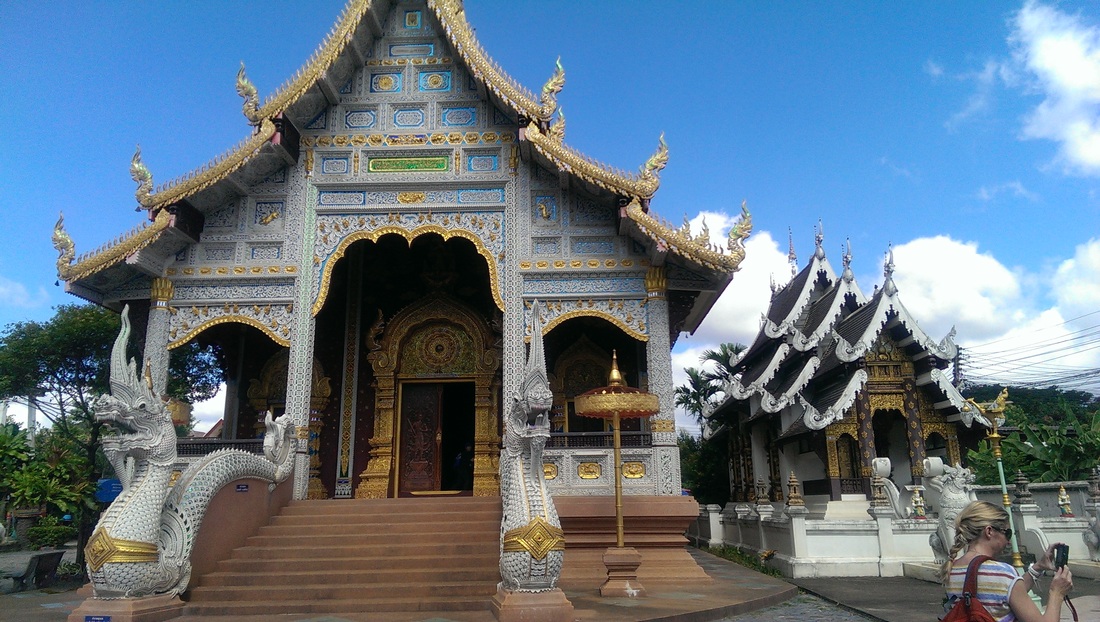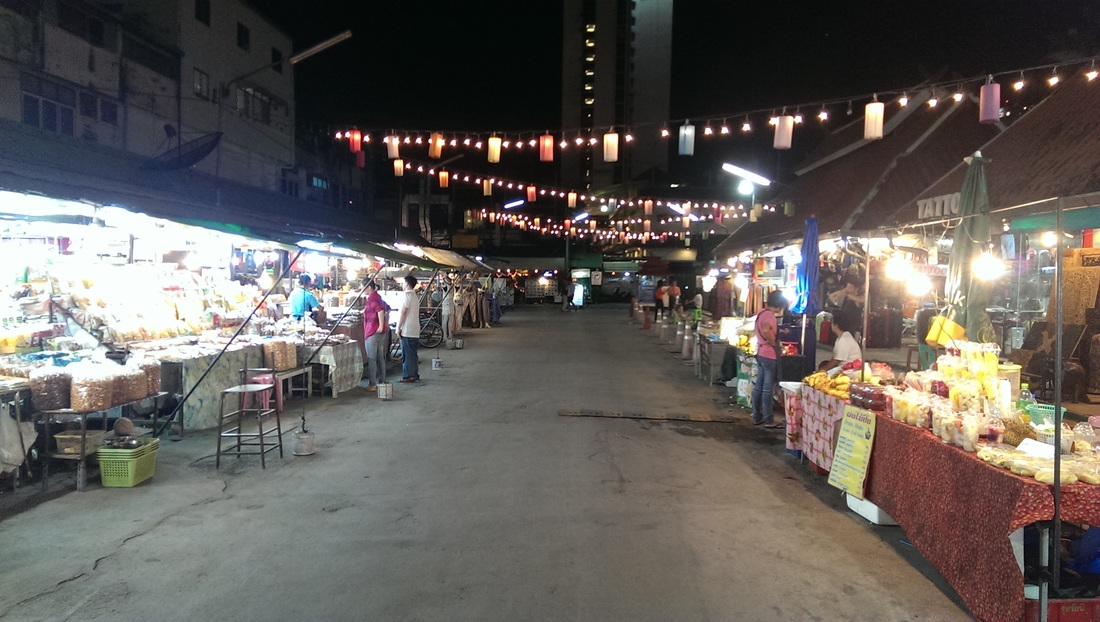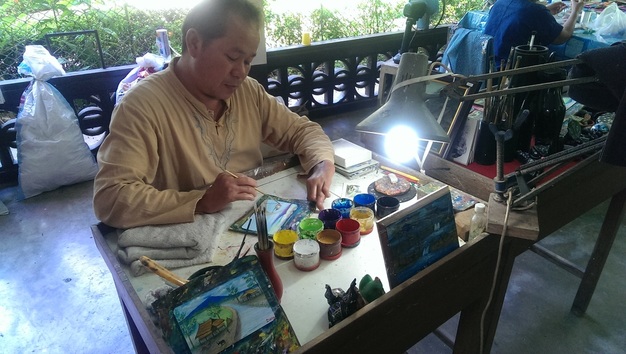SummaryAirport Rating N/A Reception of locals ***** Cost: £
Whenever I get asked what my favourite city that I visited is, the answer is always the same - Chiang Mai. There is a buzz about this city that isn't easily explained and must be experienced. I travelled to Chiang Mai via coach after spending a few days in Lampang. Surrounded on all sides by hills and mountains, Chiang Mai is built in the valley and naturally very beautiful, although the fact it is built in a valley could explain the humidity. I thought Bangkok was humid, this wasn't far off. After getting some food, I headed off to Doi Suthep, a temple on the edge of the city. The temple is about a 45 minute drive from the city centre along a beautiful ,scenic winding road up the side of a very steep hill. As I reached the end of the road for cars, I stepped outside into a busy market place set up at the base of the temple, as with most other tourist attractions in Thailand, stalls ranged from Doi Suthep themed souvenirs, to strange objects, clothes and quite uniquely, swords. As I walked through the markets I reached the end of the paved road and was greeted by a 300 step naga guarded staircase. The Yakuza MonkIt looks/sounds quite steep, however it doesnt take more than a few minutes to climb to the top of the stairs and arrive at the entrance of a magnificent temple. The temple was originally built around a stupa (dome shaped building used as a Buddhist shrine) in 1383 and has since been expanded. According to an ancient legend, an old Buddhist Monk had a vision that told him to go to Pang Cha and look for a relic. At Pang Cha, the Monk found a bone that displayed a number of supernatural characteristics. He presented this to the King of Sukhothai, however the relic failed to show in magic in his possession. The Monk and the relic were then called by a Northern Thai King, Nu Naone, to bring the relic to this kingdom. Here the relic broke in two, one piece was buried, another was attached to the back of a local white elephant which was then released into the jungle. The elephant climbed up to Doi Suthep where it trumpeted three times before falling dead. The King interpreted this as an omen, and immediately ordered the construction of a temple at Doi Suthep. There is a large statue of a white elephant at the entrance of the temple. As with all temples in SE Asia, appropriate clothing must be worn. For men, this means no shorts higher than knee length (if you're into weird short-shorts) and for women, the same conditions apply as well as ensuring shoulders are covered at all times. Within the temple there are a large number of bells (which you can ring), pagodas and statues of Buddhist and Hindu points of worship. The temple grounds are relatively large and you can easily spend an hour walking around the grounds. It was my second opportunity to meet with a Buddhist Monk. We were told this particular Monk was a former member of the Yakuza (Japanese Mafia) and had changed his path after a spate of killings. He took an interest in my appearance and I told him, through an interpreter that I was Sikh. This seemed to make him happy. I'm not sure if he had a good experience with a Sikh previously or that he knew that our beliefs are quite similar in terms of meditation and karma but it definitely put a smile on his face which was quite nice. He tied a small string around my wrist and sprinkled some water over me. I'm not sure if this makes me a Buddhist or a member of the Yakuza, but it was a very good experience. At the southern end of the temple is a large clearing where, on top of a large hill, you can see the whole of Chiang Mai, its an absolutely stunning sight, and one I recommend as worth seeing. Cycling tourOne of my favourite days in the city, and from my couple of trips to SE Asia as a whole was a day spent cycling around Chiang Mai. It really made me appreciate the beauty of the city in a completely different way. I woke up quite early and headed to a local tour guide who would be leading the ride. I was joined by a woman from Australia who I became good friends with. You are given a bike and a bottle of water. She recommended that we wear helmets, but I had tied a pretty strong patka that day (it was a good patka kind of day) so I declined. Helmets can always be a problem, especially with dastaars, but in SE Asia, helmets are optional as opposed to something that is strictly enforced, so there were never any issues. The guide helps 'fit' your cycle to ensure that you are comfortable. I would definitely recommend spending a bit of time on this as the ride is quite long (around 3/4 hours) and the last thing you need is to be uncomfortable throughout the ride. I had to make a couple of adjustments throughout the day, but nothing too major. We began by cycling along the streets of downtown Chiang Mai, traffic was generally light, but some of the main roads had a substantial amount of road users. Turning left is quite easy, but turning right is a risk every time you do it, every time I did it, my heart would race that little bit faster. We took a southern route, following the Ping River, along its banks. Our first stop was the local village temple, covered in gold. We sat in the temple a short while, admiring the paintings on the walls and ceilings and looking at the large Buddha statue at the front of the hall. After cycling in the heat, and stuffiness of downtown Chiang Mai, it was nice to be in the cool shade indoors for a while. Back on the road, we headed toward a former leper centre that is now a rehabilitation clinic, Built in the early 1900's in a European style, the ground of centre are physically stunning, with dazzling lakes covered in large lillipads. I walked inside and met some of the patients that were being treated. There are some sights that as soon as you see them, you know they will stay with you forever. For me, it was being introduced to a 14 year old boy. Less than a year earlier, he was involved in a road traffic accident whilst riding his scooter which had left him severely brain damaged. He couldn't eat, drink, talk, walk or even sleep without assistance. Most of his bones were broken and it was one of those moments where you really do have to hold back the tears. It was amazing to see how hard he was working at rehabilitation, but the nurses told me, it is unlikely he will ever be able to regain his independence. Just a little further along, housed in a different building, I met a guy who had been left paralysed by an electric shock that had left him fighting for his life. He is rehabbing in the clinic but also producing paintings. He was unable to speak, but his paintings were very powerful, so I decided to buy one of a sunset over rural Chiang Mai. It's difficult leaving an environment like that without feeling a little emotional, but the strength and spirit of the people being treated is something that will stay with me forever. We continued our bike ride, heading off the beaten track into rural Chiang Mai. We cycled through a number of small villages, every time we would go through one, little kids would run out and and after us for a few minutes which was very fun. Going through the villages, you get a bit of experience of the day to day lives of rural Thai's in the north of the country. There are a large number of fruit orchards and rice paddies surrounding the villages and there was something so peaceful and serene riding through dirt roads, with mountains in the distance, surrounded by greenery. A couple of hours into the ride, we arrived at Wang Kum Kam, a site of archaeological and historical importance. The ancient city was built in the 13th century but after repeated flooding and a Burmese invasion, it was abandoned by the 16th century. The most impressive site is the large temple, Wat Chedi Liam. The temple was built in 1287, however was renovated by a Burmese trader in the early 1900's, therefore it has a number of Burmese influences in its architecture. We stayed here for about 30 minutes, exploring the ancient ruins and looking around the temples. The tall white temple of Wat Chedi Liam is a majestic piece of architecture, and even after seeing it for 20 minutes I was still discovering new details. Singh's and night marketsChiang Mai also has a vibrant nightlife, focused on the fact that it has a lot of tourists. I joined one of the many street parties one evening and was struck by just how open and friendly everyone was, although it was obvious there were a lot of people under the influence of drugs. The carnival atmosphere continues until early morning. My friend had told me about a Singh in Chiang Mai who owned a suit shop called 'Fashion King', I followed his directions and reached a shopping centre (eventually) after a long tuk tuk ride. I then spent a further hour walking around the general area. As soon as I saw a Khanda on the shop sign I knew I had arrived. I walked in and was welcomed by a Singh like I was an old friend. He offered me drinks and asked where I was from. He then sat me down in his office and we talked about Sikhi in Chiang Mai and Thailand more generally. He informed me that his family had moved in the 1800's and there was a small but vibrant Sikh community in the city. We spoke about differences in culture, and even a few differences in beliefs as well as corruption in important institutions. As he had left Panjab around the time of British rule, he held some very puraatan (ancient/original) beliefs that were wonderful to explore. Without realising, 2 hours had passed. The Singh (who called himself Frank) is one of the most friendly and open people I had the pleasure of meeting and I felt absolutely overjoyed spending some time with him. I stayed near the famous Chiang Mai night bazaar. This was easily the most impressive night bazaar in Thailand, rivaled perhaps only by the Siem Reap one in Cambodia for my favourite night market in South East Asia. Walking through the narrow aisle's in the hot night weather was very satisfying, from funny t-shirts to the most beautiful paintings I have seen this market had it all. It even had a 'fish pedicure' where little fish clean your feet. I heard some nightmare stories about blood diseases being passed through these pedicures so I stayed clear. After a few weeks in Thailand, you almost get used to the ladyboys, but the ones in Chiang Mai were very confident and aggressively trying to get people to watch their shows, I'm sure its fun, but its not for me so I took the long route around to make sure I avoided it. At the other end of the market is an ice cream parlour that makes fresh ice cream, Maybe its the ingredients they use, maybe its the methods they employ, or maybe it was after a 2 hour walk in the heat, but this was the tastiest ice cream I have ever had. Sometimes I'm tempted to go all the way back just for the ice cream. They had an area where a live band was playing so I sat listening to them for a couple of hours and started talking to a few travelers. I ended up staying until the area closed a number of hours later. The market spills out of the area into surrounding streets, its like the whole place comes alive late at night. Every stall is open to haggling, from fake CK boxers, to cool t-shirts, to paintings, ornaments, everything can be haggled, and the price comes down very fast as soon as you start to walk away. There is something about this jewel of a city that, as much as I can attempt to describe, needs to be experienced. The vibe, the atmosphere is totally unique. Its relaxed, but not in the boring, beach type of way. There's a buzz about the city, but not in the hustle and bustle of a capital city type of way. There are sights that are similar to other parts of Thailand but with their own unique twists. Even the cuisine has influences of its neighbour countries. Chiang Mai features in any of my top 3 lists and if you get the chance, definitely do not pass visiting this gorgeous city.
Comments are closed.
|
AuthorBritish Sikh, born in the Midlands, based in London, travelling the world seeing new cultures. Categories
All
|










 RSS Feed
RSS Feed